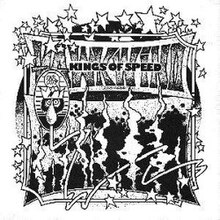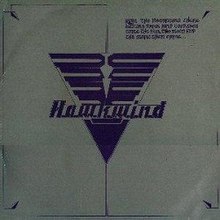Motorhead (song)
| "Motorhead" | |
|---|---|

Original single picture sleeve
|
|
| Single by Hawkwind | |
| from the album Warrior on the Edge of Time | |
| A-side | "Kings of Speed" |
| Released | 7 March 1975 |
| Recorded | January 1975 |
| Genre | Hard rock, space rock |
| Length | 3:02 |
| Songwriter(s) | Ian Kilmister |
| Alternative cover | |

Reissue single cover
|
|
"Motorhead" is a song written by Ian "Lemmy" Kilmister while he was a member of the English space rock band Hawkwind. It was later recorded by (and was the eponym for) Motörhead, as he called it this instead of Bastard on his then managers advice.
"Motorhead" was the last song that Lemmy wrote for Hawkwind before being fired from the band in May 1975. It was originally released as the B-side of the single "Kings of Speed" on United Artists Records in March 1975.
The song was written in the Hyatt Hotel (a.k.a. 'Riot House') in West Hollywood, California. Lemmy explains how it was created:
I was on tour with Hawkwind in 1974, we were staying at the Riot House and Roy Wood and Wizzard were also in town. I got this urge to write a song in the middle of the night. I ran downstairs to the Wizzard room, got Roy's Ovation acoustic guitar, then hurried back to mine. I went on to the balcony and howled away for four hours. Cars were stopping and the drivers were listening then driving off, and there I was yelling away at the top of my voice." - Lemmy.
The title of the song is American slang for a speed freak. The lyrics were explained by Lemmy:
The six thousand miles was a reference to Los Angeles, and the rest is self-explanatory. And yes, I am the only person to fit the word 'parallelogram' into a rock'n'roll number! I'm very proud of that.
The guitars and bass are tuned down a 1/2 step on the Hawkwind version, effectively making the song's key Eb Major, but are described here as if in standard tuning. The bass follows the root note for all the chords, with a riff on the F♯, based on the A string between the tenth and twelfth frets. The introduction is in E, ending with two bars each in D and E♭. The verse is in E with a D/E 'kick' at the end of each lyric line, a pre-chorus follows, in G with two lines ending in D, the last in F♯. The chorus, like the pre-chorus is in G, but with only two lines, ending in D and F♯. The song consists of three verses in total. The solo break, on the verse/pre-chorus/chorus pattern, is after the second chorus.
...
Wikipedia
